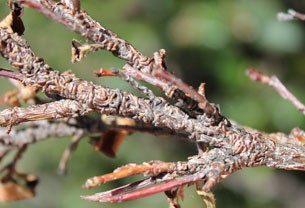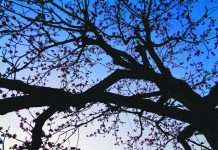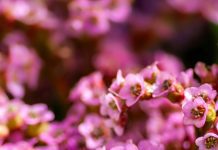Submitted by Marie Semenick-Evans
I discovered oystershell scale about 4 years ago. I had been aware that other people in Crescent Heights had some trouble with some sort of ‘pest’ that was killing their cotoneaster hedges, and always felt lucky that it wasn’t mine. People were cutting their hedges down to the ground only to have them grow and get infested again. Then, one year in early May, I found a dead patch on my hedge with scales on the bark. Right away I contacted my arborist who confirmed what it was – oystershell scale.
Yes, oystershell scale has infested our neighbourhood, as well as many other communities in Calgary. The unfortunate reality is that many people don’t know what it is or how to treat it, so it continues to plague our shrubs and trees.
What is oystershell scale?
Oystershell scale belongs to a group of insects called the armored scales and is an introduced pest in Calgary. It has the appearance of tiny brown to gray oyster shaped scales, usually densely packed, that cover bark on shrubs and trees. The pest only reproduces once per year, with the egg hatch occurring in early to mid June over about a ten-day period.
Once hatched, the “Crawlers” feed on fluids in the twigs and branches; they then permanently attach to the branch, developing a hardened shell that protects them from predators, the elements and most pest-control methods.
How do you know you have an oystershell scale problem?
- Symptoms of infestation don’t usually show up until your shrub or tree is heavily infested. Infested cotoneaster hedges die-back in patches, leaving large voids in the hedge.
- Look for branches/bark with oyster-shell shaped bumps, leaves turning yellow, and branch dieback or gaps in your hedges.
- For early detection, in early to mid-June, take a piece of black paper and shake the branches over it. If scale is present, you will see many tiny yellowish crawlers (the immature stage of the insect).
What plants are at risk?
Oystershell scale has been recorded on over 120 species of plants. In Calgary, cotoneaster is the preferred host, but it has also been seen on our fruit trees, hawthorn, mountain ash, green ash, lilac, maple, poplar, dogwood, saskatoon, amur cherry, ‘Schubert’ chokecherry and willow.
Is there a natural predator/defence?
The main predators of oystershell scale are lady bugs and lacewigs, but they are not known to be of sufficient numbers to control the scale.
How is it Spread?
Oystershell scale can be carried by wind or on the bodies of animals (birds, squirrels) that move from tree to tree. The male insects that fly in July to mate and then die, also spread the infestation. And, the use of unclean hedge trimmers by maintenance companies further contributes to the spread of the scale.
What can you do?
- Treat your shrubs/tree in spring when the oystershell scale eggs hatch. This is when they are vulnerable to treatment methods. You’ll have about 10-14 days anywhere from the end of May to mid-June, depending on the weather conditions.
- Spray your hedge once the eggs have hatched with a dormant oil spray (Purespray Green Oil) or with Malathion or Permethrin (insecticides).
- Spray with a summer oil, which can smother the nymphs for another week or two after the crawlers, but before the waxy adult covering forms.
- Branches that are heavily infested should be pruned out.
- If your hedge is heavily infested, cut back the hedge to about 8” above grade in late winter, before bud-break. In June be sure to spray the sprouting stumps with a contact insecticide – oystershell will attack stems right to the base of the plant.
**To avoid spreading, infested branches should always be bagged immediately and tied closed and should not go in the green cart. - Hire a licensed pesticide applicator to treat your shrubs/ trees.
- Be aware of misinformation – do your research! Throughout my research, I discovered that there is a lot of poor advice being given that contradicts the facts and unfortunately it is often coming from tree service and landscaping companies.
So, what did I do? I wasn’t willing to leave things up to chance with my cotoneaster hedge that I had planted and nurtured for so many years. I did a lot of research and discovered that this is not an easy infestation to deal with. So, to deal with it, every spring I call up Shane at Wild Rose for a regular annual treatment. I believe it has been treated with a variety of methods – both oil and insecticide. Four years later, I’d say it’s been about 98% effective and my hedge is thriving.
There’s no question that I am in it for the long haul – so long as others are unaware of the existence of oystershell scale or choose not to treat it, it’s going to be an ongoing battle.
Information was gathered from the following sources:










